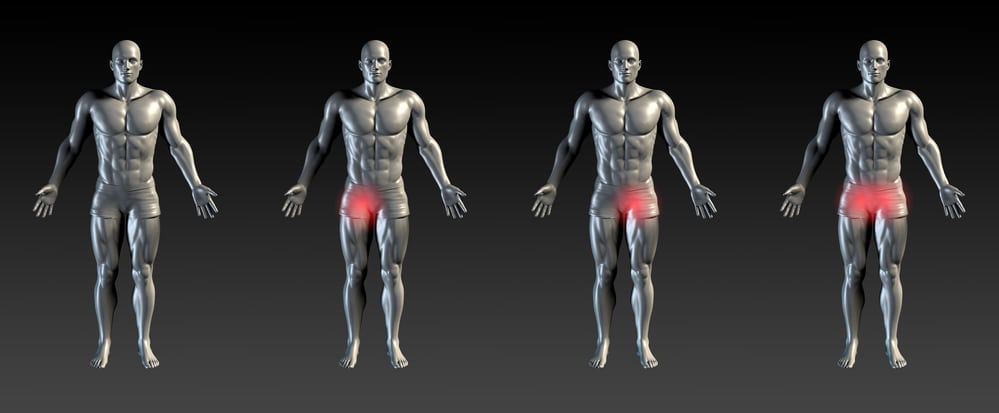The groin is the area of the body where your stomach meets your leg and can be the source of pain that ranges from mild to severe. Due to its placement, groin pain can be anything from a mild nuisance to a major hindrance on daily activities. Furthermore, sure to the network of muscles, nerves, and joints in this region, pain may also indicate any number of ailments from muscle strain to kidney stones.
Keep reading to find out if your groin pain is a minor inconvenience, a symptom of a potentially larger problem, and what treatment options are available to you.
5 Common Causes of Groin Pain
Muscle Strain
By far the most common cause of groin pain is muscle strain. Caused by a tear in the soft tissue, groin strain ranges in intensity from mild to severe. In most cases, muscle strains can be resolved with rest and the help of a physical therapist.
Treatment
Over-the-counter pain medication and rest are the most common treatments of groin pain resulting from a muscle tear. In some cases where the pain is persistent or severe, physical and massage therapies can be used to promote pain reduction and healing.
Labral tear
The labrum is a band of cartilage that wraps around the hip joint. Issues with the labrum can range from small to large tears, often causing a stabbing pain when moving the hip at various angles. Depending on the location of the tear, pain includes potental discomfort in the buttox.
Get Back Your Normal Life Again
As pain specialists, we can guarantee that we are more than qualified in alleviating your pain and treating your condition.
Treatment
Generally speaking, labral tears will heal with rest. Pain reduction methods used while healing takes place includes any over-the-counter anti-inflammatory pain medication (such as ibuprofen) in addition to physical therapy.
For labral tears which cause consistent pain or are unable to heal on their own, surgery may be required to remove the fragmented cartilage.
Arthritis
There are two common types of arthritis that create pain in the groin: Hip Osteoarthritis and Femoral Acetabular Impingement (FAI). Both afflictions are caused by wearing away from the hip joint.
Like in other forms of arthritis, Hip Osteoarthritis occurs when the cartilage of the hip joint is worn away. This particular type of hip problem causes hip and groin pain in the individual ranging from mild to severe.
In the case of FAI, bone spurs develop on the hip joint causing groin and hip pain from the increased friction.
Treatment
Choosing the right treatment for arthritic pain depends largely on the severity of the condition and whether there is a chance it will progress into a debilitating condition over time. Because there are many levels of arthritic pain that impact general functioning, several treatments exist.
Non-invasive treatments can include pain reduction medication such as steroids and anti-inflammatory agents. Arthritic pain can also be soothed by hydrotherapy, massage therapy, and physical therapy.
Note that after a certain point, medication and therapies are not enough to manage arthritis. As the condition itself occurs on the bone-level, sometimes the only way to fully solve the problem is to undergo surgery on the joint such as a hip or knee replacement. In cases where extensive surgery may be required, make sure you speak with your medical provider to fully explore and understand your options.
Kidney Stones
A kidney stone is when a calcified mass passes through the ureter and bladder to be passed. Kidney stones are known to be a painful condition with pain originating in an individual’s flank and radiating toward the groin.
Treatment
While kidney stones are often passed on their own, larger masses may require medical intervention to break up or eradicate. Such treatments include shockwave therapy, ureteroscopic removal, and laser lithotripsy.
Inguinal Hernia
A hernia occurs when something inside the body protrudes in an unnatural manner. An inguinal hernia is one which occurs when the fatty tissue of the intestines protrudes, causing pain, pulling sensations, dull ache, or even a visible bulge. Movements engaging the groin muscles are most likely to result in an increase of symptoms.
Similarly, a less common form of this condition is called a sports hernia. Most commonly, sports hernias are only diagnosed in individuals who participate in physically demanding sports such as soccer or hockey where the movements and impact of the sport can weaken the abdominal wall.
Treatment
Depending on the severity of the hernia, your doctor may choose to have you fitted for a truss– an externally worn support device used to give extra support to the weakened abdominal wall. For instances where the hernia has become severe, a surgeon can perform a hernioplasty. Here, the herniated intestine material is put back into place and the abdominal wall is surgically reinforced with mesh.
When to See a Pain Management Expert
When pain begins to get in the way of your life, that is when fast and effective treatment is needed most.
The Arizona Pain and Spine Institute boasts a full team of seasoned professionals who specialize in minimally invasive and clinically proven modalities to help manage both long and short-term pain. We make a point to stay on the cutting edge of new technologies to help reduce pain and increase quality of life.
Contact us at (480) 986-7246 for more information on the service we provide, find which doctor is right for you, and get on the path to discussing your next treatment options.

